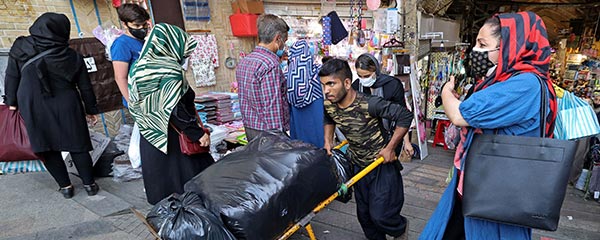WASHINGTON, D.C. -- Iranians remain unenthused about their current leadership as they prepare to vote in elections on Friday. The turnout -- and outcome -- could have implications for future leadership, given the nearly 85-year-old Supreme Ruler Ayatollah Ali Khamenei’s advancing age.
Ahead of their first visit to the polls since the national uprising sparked by the death of Mahsa Amini in police custody in 2022, a slim majority of Iranians (52%) disapprove of their country’s leadership, while 43% approve. Their displeasure is nothing new: Disapproval has been higher than approval in most years since 2018.
In the coming elections, Iranians will choose all 290 members of the Majlis -- Iran’s representative parliament whose role involves building consensus on key policies and decisions -- as well as 88 clerics in the Assembly of Experts, the body responsible for choosing Iran’s supreme leader.
The last presidential election, in 2021, was defined by record-low voter turnout. As such, Khamenei has urged voters to turn out in greater numbers this time around.
Young Iranians under the age of 30 -- a key part of the protest movement after Amini’s death -- are particularly disapproving (61%) of their leadership. With those younger than 30 making up over 60% of Iran’s population, their view toward Iran’s leadership may prove decisive in Khamenei’s call for greater turnout and the outcome of the vote itself.
Economic Struggles Affect Millions
At a crossroads politically, Iranians are slightly less bleak today about the direction of their local economy than they were a few years ago, but on the whole, more of them see conditions getting worse (50%) rather than better (33%).
A clear majority (80%) of Iranians also believe it is a bad time to find a job where they live, making Iran one of the most pessimistic countries in the Middle East and North Africa region for employment optimism, well below its close rival, Saudi Arabia (where 67% say it is a good time).
The rate of inflation in Iran has been higher than 40% for several years, as the economy remains under sustained pressure from U.S.-led sanctions. Food prices in particular are high compared with the rest of the region.
As inflation remains high and puts pressure on household budgets, three in five Iranians (61%) find it difficult or very difficult to get by on their present incomes. Since Gallup started surveying Iran, the number of Iranians finding it difficult on their incomes has never been higher.
Iranians Warm to Beijing, Cool to Moscow and Icy to Washington
Iranians may see China as an economic lifeline, which could help explain why they continue to hold China’s leadership in higher esteem than is the case for any other major power they are regularly asked about. A slim majority of Iranians (51%) approved of China’s leadership in 2023, far outpacing the leadership of Russia (31%), which has seen approval cool since its invasion of Ukraine.
Just 10% of Iranians approve of U.S. leadership, which is in line with sentiment since 2018.
In 2011, just 18% of Iranians approved of China’s leadership, tied for the lowest in the Middle East. The trading relationship between Iran and China grew substantially after the turn of the century, and Beijing remains Tehran’s most important trading partner today. China also became Iran’s largest market for oil, in defiance of U.S. sanctions.
Fast forward to 2023, and Iranians are now far more approving than any other country in the Middle East toward Beijing. Even though the rapid growth in pro-China sentiment in Iran has flattened in the past two years, more Iranians continue to approve of China’s leadership (51%) than their own (43%).
Young Iranians Are Looking for the Exit
Given their gloomy economic outlook and the political pressures at home, more Iranians today say they would leave Iran if they could. According to data from the Organisation for Economic Co-operation and Development (OECD), Iran experienced the fastest increase in migration growth rate to OECD countries globally between 2020 and 2021.
Gallup data from 2023 show that more than one-quarter (26%) of Iranians would like to move permanently to another country, double the rate from 2014 (12%). More than two in five Iranians aged 15 to 29 (43%) would also like to move abroad permanently.
Bottom Line
Iran heads into its latest vote facing numerous pressures, internal and external. While it suppressed the popular uprising of 2022 after Amini’s death, Iran’s leadership continues to receive higher disapproval than approval -- notably lower than its close trading partner, China, does. Iran’s economy continues to creak under the heavy weight of U.S. sanctions as millions feel the pinch in their pockets and job prospects.
Furthermore, the war between Israel and Hamas has brought Iran’s role in the wider region into sharp focus. Groups backed by Iran across the Middle East -- what it refers to as the axis of resistance -- such as Hezbollah in Lebanon and the Houthis in Yemen have inserted themselves firmly into the conflict as it has spread, resulting in several U.S. strikes against them.
While this election will not choose a new supreme leader of Iran, the next assembly that Iranians are voting on likely will. As a result, the pressures of economic hardship and leadership disapproval felt today could well reverberate in the future direction that Iran takes.
To stay up to date with the latest Gallup News insights and updates, follow us on X.
For complete methodology and specific survey dates, please review Gallup's Country Data Set details.
Learn more about how the Gallup World Poll works.




